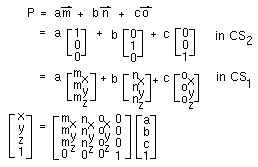
Suppose we have two coordinate systems, CS 1 and CS 2, having
coincident origins, but having different orientations:

The transformation between the two coordinate systems can be obtained as follows.

The elements of the top-left 3x3 portion of any geometric transformation are really the basis vectors of the local coordinate system expressed in the coordinates of the new coordinate system.